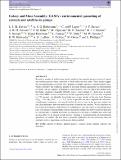Files in this item
Galaxy And Mass Assembly (GAMA) : environmental quenching of centrals and satellites in groups
Item metadata
| dc.contributor.author | Davies, L. J. M. | |
| dc.contributor.author | Robotham, A. S. G. | |
| dc.contributor.author | del P. Lagos, C. | |
| dc.contributor.author | Driver, S. P. | |
| dc.contributor.author | Stevens, A. R. H. | |
| dc.contributor.author | Bahé, Y. M. | |
| dc.contributor.author | Alpaslan, M. | |
| dc.contributor.author | Bremer, M. N. | |
| dc.contributor.author | Brown, M. J. I. | |
| dc.contributor.author | Brough, S. | |
| dc.contributor.author | Bland-Hawthorn, J. | |
| dc.contributor.author | Cortese, L. | |
| dc.contributor.author | Elahi, P. | |
| dc.contributor.author | Grootes, M. W. | |
| dc.contributor.author | Holwerda, B. W. | |
| dc.contributor.author | Ludlow, A. D. | |
| dc.contributor.author | McGee, S. | |
| dc.contributor.author | Owers, M. | |
| dc.contributor.author | Phillipps, S. | |
| dc.date.accessioned | 2019-10-16T09:30:06Z | |
| dc.date.available | 2019-10-16T09:30:06Z | |
| dc.date.issued | 2019-03 | |
| dc.identifier | 261905800 | |
| dc.identifier | dd243b2a-d052-416a-b372-411e456fb2d4 | |
| dc.identifier | 85062285113 | |
| dc.identifier.citation | Davies , L J M , Robotham , A S G , del P. Lagos , C , Driver , S P , Stevens , A R H , Bahé , Y M , Alpaslan , M , Bremer , M N , Brown , M J I , Brough , S , Bland-Hawthorn , J , Cortese , L , Elahi , P , Grootes , M W , Holwerda , B W , Ludlow , A D , McGee , S , Owers , M & Phillipps , S 2019 , ' Galaxy And Mass Assembly (GAMA) : environmental quenching of centrals and satellites in groups ' , Monthly Notices of the Royal Astronomical Society , vol. 483 , no. 4 , pp. 5444–5458 . https://doi.org/10.1093/mnras/sty3393 | en |
| dc.identifier.issn | 0035-8711 | |
| dc.identifier.other | ArXiv: http://arxiv.org/abs/1901.01640v1 | |
| dc.identifier.uri | https://hdl.handle.net/10023/18686 | |
| dc.description.abstract | Recently a number of studies have found a similarity between the passive fraction of central and satellite galaxies when controlled for both stellar and halo mass. These results suggest that the quenching processes that affect galaxies are largely agnostic to central/satellite status, which contradicts the traditional picture of increased satellite quenching via environmental processes such as stripping, strangulation, and starvation. Here we explore this further using the Galaxy And Mass Assembly (GAMA) survey, which extends to ∼2 dex lower in stellar mass than SDSS, is more complete for closely separated galaxies (≳95 per cent compared to ≳70 per cent), and identifies lower-halo-mass groups outside of the very local Universe (Mhalo ∼ 1012 M⊙ at 0.1 < z < 0.2). As far as possible we aim to replicate the selections, completeness corrections, and central/satellite division of one of the previous studies but find clear differences between passive fractions of centrals and satellites. We also find that our passive fractions increase with both halo-to-satellite mass ratio and central-to-second rank mass ratio. This suggests that quenching is more efficient in satellites that are low-mass for their halo (i.e. at high halo-to-satellite mass ratio in comparison to low halo-to-satellite mass ratio) and are more likely to be passive in older groups – forming a consistent picture of environmental quenching of satellites. We then discuss potential explanations for the previously observed similarity, such as dependence on the group-finding method. | |
| dc.format.extent | 15 | |
| dc.format.extent | 3768375 | |
| dc.language.iso | eng | |
| dc.relation.ispartof | Monthly Notices of the Royal Astronomical Society | en |
| dc.subject | Galaxies: evolution | en |
| dc.subject | Galaxies: general | en |
| dc.subject | Galaxies: groups: general | en |
| dc.subject | Galaxies: star formation | en |
| dc.subject | QB Astronomy | en |
| dc.subject | QC Physics | en |
| dc.subject | NDAS | en |
| dc.subject.lcc | QB | en |
| dc.subject.lcc | QC | en |
| dc.title | Galaxy And Mass Assembly (GAMA) : environmental quenching of centrals and satellites in groups | en |
| dc.type | Journal article | en |
| dc.contributor.institution | University of St Andrews. School of Physics and Astronomy | en |
| dc.identifier.doi | https://doi.org/10.1093/mnras/sty3393 | |
| dc.description.status | Peer reviewed | en |
| dc.identifier.url | http://arxiv.org/abs/1901.01640 | en |
This item appears in the following Collection(s)
Items in the St Andrews Research Repository are protected by copyright, with all rights reserved, unless otherwise indicated.

